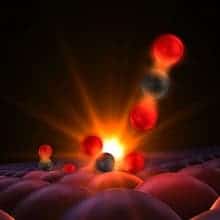Using ultra-fast laser techniques employed by the Department of Energy’s SLAC National Accelerator Laboratory, scientists have peered through the transitional state that reactants go through before joining in a molecule. The implications for chemistry are massive and the findings might spur a new field of science. Already, we’re hearing about some very interesting conclusions, although much more work needs to be done. For instance, it seems like most reactants don’t successfully join to form a stable molecule; instead, the reacting atoms vibrate in a transitional state only to break apart and try again. Just like sliding a bunch of marbles uphill – some will have enough velocity to beat gravity and go through the other side, but most will climb a bit, then fall down to their initial ground state of zero potential energy.
Spoof! A new molecule is born

The researchers, led by Professor Anders Nilsson, used a linear accelerator-based femtosecond x-ray source to image the same reaction that neutralizes carbon monoxide (CO) from car exhaust in a catalytic converter. Catalysts are compounds that can trigger a chemical reaction without being affected themselves. For example, enzymes are natural catalysts that control many important chemical reactions in living organisms. In order to reduce air pollution, modern automobiles are equipped with a device called a catalytic converter that reduces emissions of three harmful compounds found in car exhaust:
- carbon monoxide (a poisonous gas)
- nitrogen oxides (a cause of smog and acid rain)
- hydrocarbons (a cause of smog)
In our case, the researchers studied the reaction between carbon monoxide and oxygen from the air in the presence of a common exhaust catalyst called ruthenium. First, an optical laser was fired on the surface of the catalyst to increase the temperature to 2,000 kelvins (more than 3,000 degrees Fahrenheit). Temperature is actually atomic vibration. By increasing temperature, the the carbon monoxide and oxygen molecules vibrate at a higher rate, thus increasing the chance of coming into contact and forming a bond – carbon dioxide.
To peek through the reaction and see what happens inside only fractions of a second after the process started, Nilsson and colleagues fired X-ray laser pulses of short duration—lasting some 80 femtoseconds, or 80 millionths of billionths of a second. This lightning-fast strobe light allowed the researchers to image even the subtlest signs of bond formation.
“First the oxygen atoms get activated, and a little later the carbon monoxide gets activated,” Nilsson said. “They start to vibrate, move around a little bit. Then, after about a trillionth of a second, they start to collide and form these transition states.”
Surprisingly, most of the reactants enter the transition state, but do not emerge as bonded new molecules.
“It’s as if you are rolling marbles up a hill, and most of the marbles that make it to the top roll back down again,” Nilsson said. “What we are seeing is that many attempts are made, but very few reactions continue to the final product. We have a lot to do to understand in detail what we have seen here.”
The team is already starting to measure transition states in other catalytic reactions that generate chemicals important to industry.
“This is extremely important, as it provides insight into the scientific basis for rules that allow us to design new catalysts,” said SUNCAT Director and co-author Jens Nørskov.
“This is the very core of all chemistry. It’s what we consider a Holy Grail, because it controls chemical reactivity,” said Anders Nilsson, a professor at the SLAC/Stanford SUNCAT Center for Interface Science and Catalysis and at Stockholm University who led the research. “But because so few molecules inhabit this transition state at any given moment, no one thought we’d ever be able to see it.”
The findings appeared in Science Express.


